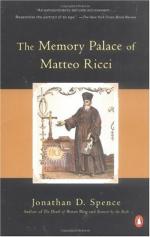
|
| Name: _________________________ | Period: ___________________ |
This test consists of 15 multiple choice questions and 5 short answer questions.
Multiple Choice Questions
1. When Ricci became a missionary in China during the 16th century, what was wrong with the science taught to the Chinese?
(a) It led to many disasters to the environment.
(b) It disregarded Western discoveries and advances.
(c) It focused on outdated principles.
(d) It lacked fundamental principles.
2. Which of these was NOT a typical gift that Ricci would give to the Chinese during his time as a missionary in the late 16th century?
(a) Religious paintings.
(b) A rhinoceros horn.
(c) A small harpsichord.
(d) Bibles signed by the reigning pope.
3. According to "Chapter Eight, The Fourth Image: The Fourth Picture", what effect did Ricci's reflections on the Virgin Mary have on him?
(a) They give him solace.
(b) They make him nervous.
(c) They make him sad.
(d) They provide him with Chinese friends.
4. According to Chapter Seven, The Third Picture: The Men of Sodom, what is the subject of the series of prints that made up third picture "The Men of Sodom"?
(a) John the Baptist's life.
(b) The Apostle Peter's life.
(c) Mary's life.
(d) Lot's life.
5. What type of life was flourishing during the 16th century when Ricci was in China?
(a) Commercial life.
(b) Industrialization.
(c) Public service.
(d) Chinese imperialism.
6. How did Ricci intend to use the third picture, "The Men of Sodom"?
(a) To convey God's power to destroy.
(b) To convey the sin of Sodom to the Chinese.
(c) To explain why Lot's wife turned to salt.
(d) To explain why Lot's daughters slept with Lot.
7. How was Pope Paul IV buried in the 16th century?
(a) With great pomp and circumstance befitting the position of a church leader.
(b) Buried in a pauper's grave to show his humble roots.
(c) With modest trappings and ceremony to honor a common man.
(d) Buried deep and late at night so his corpse would not be stolen.
8. Who was depicted in the second picture "The Road to Emmaus" that Ricci showed Cheng Dayue?
(a) Christ and two disciples.
(b) Christ, his mother, and two disciples.
(c) Six apostles.
(d) Two disciples.
9. According to "Chapter Five, The Second Picture: The Road to Emmaus", how many people were in the second picture "The Road to Emmaus" that Ricci showed Cheng Dayue?
(a) Four.
(b) Six.
(c) Two.
(d) Three.
10. What were the meanings of the two new idiographs made when Ricci split the second idiograph down the middle?
(a) Gain and benefit.
(b) Profit and loss.
(c) Grain and blade.
(d) Blade and knife.
11. When Ricci divided the fourth ideograph, "hao," what was the new meaning?
(a) "Man" and "woman" created a reference to the marriage of Mary and Joseph.
(b) "Woman" and "girl" created a reference to Mary's virginity.
(c) "Man," "woman," and "child" created a reference to the Holy Family.
(d) "Woman" and "child" created a reference to the Virgin Mary.
12. What was the state of Ricci's financial situation during most of his time in China?
(a) Increasing, as more wealthy Chinese convert to Christianity and begin to tithe to his church.
(b) Unstable, ranging from poverty to riches on a steady basis.
(c) Poverty, with a constant threat of bankruptcy and expulsion.
(d) Stable, with regular subsidies from his Jesuit order.
13. When Ricci was a 16th century missionary in China, how did he use the event of the Inquisition when teaching the Chinese?
(a) He compared the event to the story of Sodom and its moral extremes.
(b) He compared the event to the persecution of Jews around the world.
(c) He compared the event to conflict in China between the Buddhists and the emperor.
(d) He compared the event to Judas' betrayal of Jesus to the Romans.
14. What did the fourth ideograph, "hao," represent in the Chinese language during the 16th century?
(a) Obedience.
(b) Chastity.
(c) Poverty.
(d) Goodness.
15. What did Ricci NOT like about the Confucian moral system when he was a missionary in the 16th century?
(a) Its approval of animal sacrifice.
(b) Its subjugation of children.
(c) Its pantheism.
(d) Its ideas about the role of women.
Short Answer Questions
1. According to "Chapter Eight, The Fourth Image: The Fourth Picture", what doctrine were the Chinese not ready to understand when Ricci was a missionary in 16th century China?
2. During the 16th century, why had Pope Paul IV given the Inquisitors in Spain great power?
3. According to "Chapter Seven, The Third Picture: The Men of Sodom", which of these is NOT one of the things that Ricci appreciated in China?
4. During the Renaissance, what did some believe was the purpose of these groups in China that "pledged themselves to lives of heightened spiritual service"?
5. What did Ignatius encourage the Jesuits to publish when they published their first books in the 16th century?
|
This section contains 833 words (approx. 3 pages at 300 words per page) |

|




